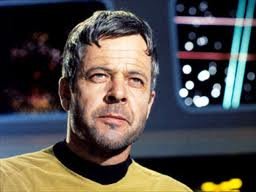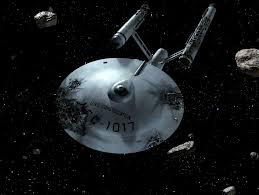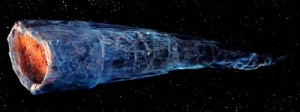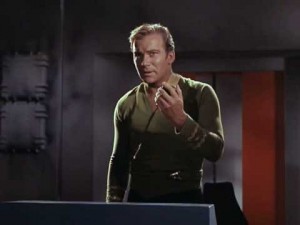Have you ever been watching a movie or reading a novel, and somewhere in the middle (aka Act 2), it bogs down? If Act 2 is sluggish enough, you’ve even lost interest in the outcome, Act 3.
Here’s what probably happened. The writer was up against a deadline and threw all manner of challenges at the characters in that midsection to perk up the action and avoid what’s known as “the sagging middle.” But ironically, the wrong kind of action can drag at the momentum.
The challenges faced by characters in the middle of a movie or novel must be more than a random series of obstacles for those characters to overcome. They must mean something to the characters’ goals. And the challenges must also relate intimately to the pending crisis.
Setup for successful Act 2 suspense
“The Doomsday Machine,” my favorite episode of classic “Star Trek,” is full of driving suspense. Some of the most memorable tension in the episode is found in the very middle, making this middle anything but saggy. Let’s see how the writer did it.
In Act 1 of “The Doomsday Machine,” the starship “Enterprise” encounters a sister ship, the “Constellation,” that’s adrift and all-but-demolished after battling a giant robot—a Doomsday Machine—that eats planets. Out of a crew of more than 400, only the commander of the “Constellation,” Matt Decker, has survived. The robot, impervious to phaser weapons from the “Constellation,” has continued on a course that will allow it to eat its way through the heart of the Milky Way galaxy. So “Enterprise” Captain Jim Kirk, temporarily aboard the “Constellation,” decides that his ship will take the broken vessel in tow and proceed to the nearest star base so they can warn Command about the threat. He sends Decker back to the “Enterprise” for medical treatment, and he and a repair team remain aboard the “Constellation” to restore minimal mobility to the starship and prepare it for tow.
That brings us to the middle of the episode. Act 2. At this point, the Doomsday Machine robot circles back into the vicinity and attacks the “Enterprise.” Decker, grieving the loss of his crew and making decisions while in the grip of post-traumatic stress disorder, assumes command of the “Enterprise.” Kirk, stranded aboard the “Constellation,” watches his ship get beat up by the robot.
The look and feel of a successful Act 2
The core of this episode’s Act 2 action plays out in the following five-minute YouTube clip. (Caveat: 1960s-style special effects ahead.) Watch how the suspense leaps back and forth between Decker on the “Enterprise” and Kirk on the “Constellation.”
http://www.youtube.com/watch?v=-SMyk-unHIk
And this isn’t even the climax of the episode.
Key points of Act 2
 Decker’s decisions at 0:07, 0:30, 1:47, and 1:56 are wrong. His credibility as a starship commander is gone. On some level, he realizes that phaser weapons from the “Enterprise,” like those from the “Constellation,” won’t stop the robot, but he’s unable to think logically. He uses the ineffective strategy of phaser barrage as a surrogate for beating on the robot with his fists. The result? The robot damages the “Enterprise” and threatens the lives of Kirk’s crew. Even though we can see this coming, it’s still suspenseful.
Decker’s decisions at 0:07, 0:30, 1:47, and 1:56 are wrong. His credibility as a starship commander is gone. On some level, he realizes that phaser weapons from the “Enterprise,” like those from the “Constellation,” won’t stop the robot, but he’s unable to think logically. He uses the ineffective strategy of phaser barrage as a surrogate for beating on the robot with his fists. The result? The robot damages the “Enterprise” and threatens the lives of Kirk’s crew. Even though we can see this coming, it’s still suspenseful.
Aboard the crippled “Constellation,” the usually-cool and often-correct Captain Kirk engages in a short-sighted act of desperation (at 1:00, 4:06, and 4:23) to draw the robot off the “Enterprise.” His act pays off for the “Enterprise.” But Kirk has made a whopper of a mistake. Fixated on saving the “Enterprise,” he imperils himself and his crew members aboard the “Constellation.” Kirk’s “Oh-sh*t!” expression at 4:40 says it all.
What else do you see that gives this sequence tension?
What this writer did well
Many have commented that the unique musical score written for “The Doomsday Machine” contributes to the atmosphere. Yes, it does, but even without music, this sequence would be suspenseful. Writer Norman Spinrad exploited the fears of Decker and Kirk, developing tension organically from personality weaknesses in both characters. Then he milked the resulting suspense in a crisis that gives viewers a taste of death.
Act 2, written well, is supposed to guide you into Act 3. Everything that happens in Act 2 of “The Doomsday Machine” sets the stage for even greater challenges in Act 3, the climax of the episode, and makes you eager to find out how the dilemma gets resolved.
Sagging midsections in movies and novels may contain random, meaningless obstacles like a car chase, explosions, a seduction, or a gunfight. Hidden behind those are opportunities the writer missed to craft suspenseful challenges that arose due to character weaknesses.
Can you name a movie or novel with a midsection that didn’t hold your attention?
**********
Did you like what you read? Learn about downloads, discounts, and special offers from Relevant History authors and Suzanne Adair. Subscribe to Suzanne’s free newsletter.




Great post Suzanne– and a timely reminder not to toss in random character obstacles just for the sake of pumping up the action. So true.
Thanks, Christine. Glad you enjoyed it. So many movies today depend on special effects. It’s all too easy to create special effects obstacles that are random. Gives the entire movie a shallow feeling.
Fun clip. I love stories where getting out of one bad situation leads to getting into a worse situation and the tension keeps building–best when the story grows out of character flaws.
Suzanne, thanks for stopping by. Yes indeed, “out of the frying pan and into the fire” works especially well when the tension is built from character flaws.
You are right, Suzanne, that’s definitely second act suspense. (I was too busy taking care of kids to watch much of Star Trek.) This reminds me that I have to do the same in my mystery.
Right-o, Norma, there’s no reason why we can’t have exciting second acts in out mysteries! As for classic Star Trek, “The Doomsday Machine” wasn’t the only episode with a good Act 2. “The Trouble With Tribbles” is a great example of blending suspense and humor.
One of my favorite original ST episodes, too. As a kid, I called it the “Giant Cigar Episode”. 😉 I can hear the nail-biting background music in my head now just thinking of it. What the 60s lacked in sophisticated special effects, it more than made up with shows that had actual good plots. Some shows today have terrific special effects with lackluster or almost non-existent plots.
For me, though, a novel with a slowwww start is more likely to lose me than one with a sagging middle. If it doesn’t get going within the first two chapters, I’m more likely to put it down and not finish it than I am to abandon one with a sagging middle. A good start gives me hope than a sagging middle will eventually pick up again.
Thanks for stopping by, Tracy. Giant cigar, windsock, big space bugle — hah! Who knows where Trek got its inspiration for that robot’s appearance? I think the incorporation of special effects in TV episodes and movies today is often done so at a cost of plot and characterization.
For me, if a novel is slow out of the gate, I skim ahead to see whether it perks up before deciding to abandon it. If the beginning moves along, but the middle bogs down, I may skim through the middle until the activity picks up again.